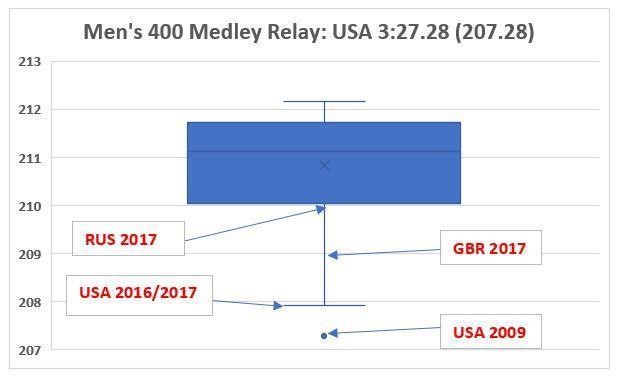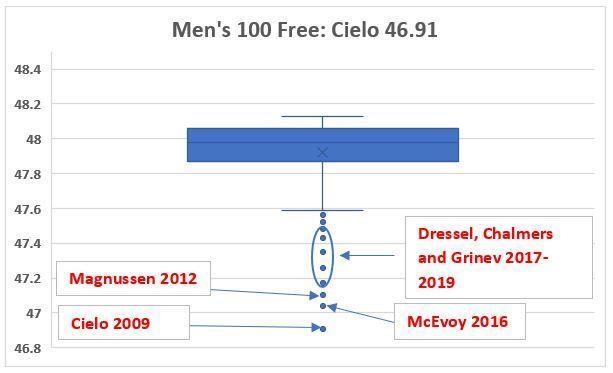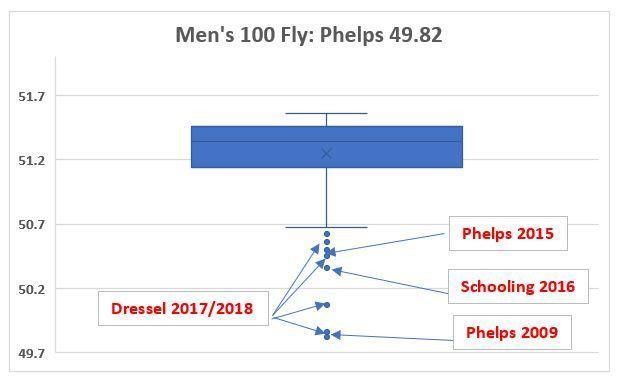Courtesy: Charge Schmerker
We are nearing the 10-year anniversary of the most ridiculous technology-aided amazing display of world record breaking swimming the world has ever seen. Over the course of a week, a total of 43 world records (in 31 unique events) were broken in Rome. How significant is that? There have only been 48 world records set at the Olympics or World Championships in the 10 years since. As we near the end of the first post super-suit decade there are still 15 super suit records on the books, including a few set in Beijing and also a handful that were squeezed in during the fall of 2009 as the super-suit ban approached. Some of these records have had close calls over the years, while others still have an untouchable feel to them a decade or more later.
We are entering a 24-month period that will see three high-level international swim meets; 2019 Worlds in Gwangju, the 2020 Olympics in Tokyo and the 2021 Worlds in Fukuoka. These three meets each give us a very high potential for world-record breaking swims, hopefully putting to bed some of these super- suited records that many of us would love to turn the page on.
I have done a deep dive into the data of the past 10 years of swimming in the 15 events that still have super-suited records hovering over them. For individual events, I mined the fastest 200 times in each event since the suits were banned. For the relay records I only used the top 50 times for reasons explained later. While using the top 200 times in the last decide does not afford us a chronological view of the progression of times (as a group or individually) towards the respective records, it does allow us to see how the very best swimmers/swims in the past decade have fared in relation to the record, allowing us to gauge both the significance of the current record as well as how the swimming world as a whole may be closing in on it.
Using these top times from the past decade of non-super-suited swims in addition to the existing world record, we can see a very clear picture of just how significant those records are in relation to the historical data since. Statistics were calculated, graphs were made……. and with a little of my own opinions and bias sprinkled in I have ranked the 15 world records in order of how likely they are to being (or not being) broken in the next three years. As a statistical note, standard deviations are typically used to measure how far a value is from the mean value (ex: A SAT test score was 1.2 standard deviations above the mean) but here I use them to compare how far a particular swimmer is from the world record, which is obviously the minimum value. This method is a tad unorthodox, but this allows us to compare the relative likelihood of records being broken across different distances, genders and disciplines.
As it is, I have broken the existing records into four tiers. Within each tier I feel legitimate arguments can be made for the swapping of event rankings, but I have gone ahead and ranked them 1-15 for the purpose of linearity and (of course) a spirited comments section. I wrote all of these with great care and spent hours doing research. If I have missed your favorite up and coming swimmer with huge potential, or missed a swim in the transfer of data from FINA.org, you have my sincere apologies. I also acknowledge that crazy stuff happens and we may see an out of this world swim by any swimmer at any time, but those are really tough to anticipate and to account for in this format. I am not always trying to estimate if a particular swimmer is capable of breaking the record, but rather just the likelihood of the record being broken at all. By someone. Soon. One final note, this is not meant as a prediction of who will win any particular event in Gwangju or Tokyo, simply a general records discussion. So, without further ado and from least likely to be broken to most likely, let’s dive in and go for a swim.
Tier 4 (Read Here)
Tier 3 (Read Here)
Tier 2 (Read Here)
Tier 1
Tier 1: Hang on tight! These records are going down!! (I mean, probably)
The remaining three records all have two things in common: very small standard deviations between the current times and the record, and Caeleb Dressel.
Number 3: Men’s 400 Medley Relay- USA; 3:27.28 (207.28 seconds)
The data: The 50 fastest relays since 2009 have a mean of 210.9 seconds with a standard deviation of 1.09 seconds.

After seeing 4 seconds of progress over the preceding 12 years, Team USA showed up in 2008 to chop over a second off the record in Beijing before showing up in Rome next summer and dropping 2.06 seconds off that new record. You’re thinking, ‘Well, yeah. Phelps went 49-point!” Sort of. Phelps did swim his 2009 leg 0.43 seconds faster than in Beijing. But, Peirsol was almost a second faster than in Beijing and Shanteau was 0.7 faster than Hansen was in Beijing. The Americans did come within 0.7 seconds in Rio (0.61 standard deviations) and then 0.04 closer in Budapest (0.58 standard deviations). So, what’s the problem, why can’t they crack it? The Americans in 2019 can match the pace of the 2009 squad in the backstroke (world record holder Ryan Murphy) and butterfly (guess who). Freestyle has been handled by Nathan Adrian historically, and he has long delivered splits between 46.6 (Walters’ split in Rome) and 47.0. What they have not solved is the breaststroke leg where they have struggled to get guys under 59 seconds, even from a rolling start, since Rome. Shanteau was 58.5 that day which is nothing to get especially worked up over these days given the presence of Adam Peaty. Yet, that is still a time that the Americans have been unable to replicate since. Andrew Wilson and Michael Andrew will be charged with that task in Gwangju, but Cody Miller and others will get their chance to be on the 2020 squad next summer. Ironically, the breaststroke may not be the American’s real problem if Nathan Adrian can’t regain his 46.6-47.00 form after missing time for cancer treatment. Assuming he can throw down one last 47.00, which isn’t a particularly huge stretch, the American can field a 51.9/59.0/49.6/47.0 relay and be right near the record. None of those times are even projections, the swimmers have been those times in the past two years, they just need to happen at the same time. Additionally, Dean Farris just delivered a 47.08 relay split in Naples and he or a number of swimmers mentioned in the 400 Free Relay section provide insurance for that free leg should the Americans need it.
Other teams could possibly crash the world record party, but only Great Britain has most of the pieces. They have a transcendent leg in Adam Peaty (56-mid), and very strong Fly and Free legs from Guy (50.8) and Scott (47.0). What they are missing is a 53-low backstroker. Going back through 2016, they don’t have a single swim within the top-100 in the FINA database. It’s hard to believe that a country with top-10 talent in three of the strokes can’t get one guy close to that relatively pedestrian threshold. Chris Walker-Hebborn was 54.54 back in Rio, but he’s hung up the goggles. Luke Greenback did just swim a 53.9 back in April and is just 21. If the Brits can just get Luke or another swimmer to that 53-low level, and soon, they would just need to get everyone on the same page on the same day and they are on the doorstep with a 53.4/56.5/50.5/47 relay. It would be a shame for them to watch Peaty’s peak performance period pass (say that three times quickly after a pint) without capitalizing. I think Team USA gets this done, but probably next summer. But if Dressel drops something special this month, watch out! Speaking of……
Number 2: Men’s 100 Freestyle- Cesar Cielo; 46.91
The data: The 200 fastest swims since 2009 have a mean of 47.93 seconds with a standard deviation of 0.20 seconds.

As a sidebar, it is rare to see this many outliers in a single distribution! After dropping roughly a second over the course of 15 years (with 5 separate resets), this record then stood untouched for nearly 8 years. The record was then dropped 7 different times, cutting off nearly a second in 16 months including three times in Beijing! Of all the records on this list, this is the one that has been rattled the most since Rome. Cameron McEvoy rocked a 47.04 at the Aussie trials in 2016, James Magnussen hit 47.1 at the 2012 Aussie Trials and Caeleb Dressel hit 47.17/47.22/47.26 in Budapest (his 47.17 is still 1.31 standard deviations from the record). Not to be forgotten, Vladislov Grinev recently went 47.43 and Kyle Chalmers hit 47.48 this April. There is some fast swimming in this event right now! With the times Dressel put down without a shave and full taper you can reasonably think he has sub-47 within reach if he has the same improvement as he did between trials and worlds in 2017. Kyle Chalmers is still so young, with plenty of potential growth left in him as well if he doesn’t retire after 2020. Was his 47.48 tapered? Semi-tapered? He could well have something special in store himself. In addition to those two you have Grinev, Vlad Morozov, Domink Kozma and Marcelo Chierighini that all have flat starts or relay splits in recent years that suggest a sub-47 time could potentially happen if the stars align. My money is on Dressel with Chalmers right behind him. Both guys are still young, still have excellent developmental curves and plenty of motivation and competition. That’s the race everyone has been waiting for since Budapest. This is going to be a fantastic race in both Gwangju and Tokyo with not only multiple guys that can win, but set the record while doing it.
You ready?
Number 1: Men’s 100 Butterfly- Michael Phelps; 49.82
The data: The 200 fastest swims since 2009 have a mean of 51.25 seconds with a standard deviation of 0.30 seconds.

When beginning to write this monstrosity I assumed two things to be certain. I assumed there would be lots of debate amongst the first 14 events. I also assumed there would be close to zero debate about #1. When this record was set, it seemed as nearly as stunning and untouchable as 1:42.00, 3:08.24 and 46.91. Through London, Michael Phelps was the only man to break 51 seconds in the post-suit era. Much like the 50/100/200 Free, this record had an aura to it. Then a crazy thing happened after 2012, a staggering 8 swimmers broke through that 51:00 barrier and began creeping their way down towards the record through Rio. Then an even crazier thing happened. Caeleb Dressel showed up in Budapest after swimming a 50.87 at the USA trials a month earlier. Was he tapered in Indy? A 50.87 was already his lifetime best. Even after his electric swims the first few days in Budapest the question remained, “What would his 100 Fly look like?”. A 49.9 rolling start in the mixed medley relay certainly got our attention. Back-to-back 50.08 and 50.07’s in the prelims and semis answered our questions. The earth shattering 49.86, while seemingly accelerating the last 10 meters? (He didn’t accelerate but it was close) That put an exclamation mark, bow, ribbon and fireworks on the thing. 2018 was a letdown for all of us, Dressel included I’d imagine. Dressel got our attention again last month with what we assume was a non-shaved/slightly-rested 50.35. That is a time that would have won every single meet in history except for 2009 and 2017 Worlds! Oh yeah, did I mention he wasn’t shaved and likely not tapered?
Declaring before this trifecta of swim meets that this record will be broken seems a little presumptuous, but it’s hard to imagine it not going down. Not discussing the other players in this event is not a sign of disrespect. Milak is a hell of talent, Schooling is the Olympic Champion and Guy/LeClos/Metella all have immense talent. Any one of those guys could have the swim of a lifetime and approach the record. Yet, in my mind this race is all Dressel.
There’s my list! I hope you enjoyed reading it as much as I did researching it, and here’s to some fantastic swimming in the next 24 months!
About Charge Schmerker
 Charge first got his feet wet at the age of 5 with the SugarLand Sharks in suburban Houston. After swimming competitively through high school, he hung up his goggles to attend and eventually graduate from The University of Texas at Austin. Although he swims now only swims for the exercise, he is still an avid fan of competitive swimming.
Charge first got his feet wet at the age of 5 with the SugarLand Sharks in suburban Houston. After swimming competitively through high school, he hung up his goggles to attend and eventually graduate from The University of Texas at Austin. Although he swims now only swims for the exercise, he is still an avid fan of competitive swimming.
Charge is currently involved in educational consulting and teaches AP Statistics in Plano, Texas.


Nice article! I just found this after watching Worlds. Looks like your predictions here (only read Tier 1 so far) nearly came to fruition! Dressel did even better than I could have expected, freaking incredible. 100 fly WR shattered. Came so close to the 100 free record, but essentially there. The relay was disappointing for the US but I mean, all hats off to Adrian. I had no idea he had been battling cancer until I heard Rowdy on the air. I’m impressed he was even swimming after that piece of news. Though even if Adrian threw down a 47 flat and grabbed gold, like what he did in the free relay, they would have needed a faster leadoff from… Read more »
I’m surprised no one else has said this, so I’m gonna go ‘head an be that guy: I found this series to be hypocritical and xenophobic. For starters, the ‘supersuit era’ started in 2008 with the LZR Racer from Speedo; if you’re gonna blame anyone for unleashing that cat out of the bag, there’s your culprit. Second, who is actually surprised that more records were gonna be set by swimmers of non-US birth? I mean, Arena basically reverse-engineered the LZR to compete on the international stage. It was a natural leap. Third, for Michael Phelps to say during the ’09 Worlds “I cant wait for swimming to get back to swimming” is not only biased, but its salty AF considering… Read more »
I don’t see how this series is any of those things. This is basically a purely statistical analysis with a bit of personal bias and analysis. I will not comment on the rest of your post as there’s plenty of argumentation out there on those points already.
Chalmers’ PB is 47.35 from trials.
Correct! Pulled the wrong swim of that page of the spreadsheet 🙂
Even though it was rated as a Tier 2, I think the most likely to go is the women’s 4X200FS. I see the USA and Australia both breaking it at the upcoming WC’s.
I’m with you. Thus, more then the men’s 100 fly is the record I’ll be most disappointed if it doesn’t go down at WC.
Regarding the breaststroke leg of the MR, Kevin Cordes went a 58.8 split at 2015 Worlds, despite not swimming the 100 breast as an individual event, due to getting DQ’d at nationals. Great call by the coaches, both for the team, and for Kevin’s confidence.
Absolutely. The USA has had a few relay 58.8’s since 2009, but we haven’t progressed in the event like we have in the other strokes since 2009
It’s odd, the super suits clearly allowed a very different type of swimmer (built like a tank, lightning on a 50) to hold on for 100, whilst the 200 was still dominated by guys who were primarily 200 freestylers without the suits (Biedermann, Phelps and Izotov all focussed on the 200 throughout their career). You didn’t see bigger, quicker more 100 focussed guys like Adrian suddenly putting up world class 200s.
But despite that, it’s the 200 record which is completely out of sight whilst the 100 is likely to go in the next couple of years.
I think you’re talking about an aerobic versus anaerobic situation, especially in LC. I am certainly not proposing that the 100 is not at all reliant on your aerobic capacity because you don’t see anyone trying to know no breathe a 100 freestyle. But the real issue in my experience in the 100 during the last 15 to 25m is still muscle fatigue as opposed to oxygen debt. So, IMO, the suits streamlined those big guys And kept their body position high in the water. This reduced their drag and kept their muscles just a tad bit fresher for those last 15 m. With a few notable exceptions, like Bernard’s leg in the 2008 relay, the super suit guys weren’t… Read more »
I agree and especially in LC compared to SCY where you could see Adrian swim a relatively fast 200.
Think the medley relay record is still a year away, with the Americans’ iffy breast and free legs and the Brit’s back leg at this year’s Worlds.
What is the consensus (if there is one) with how much the supersuit helped breastroke? I forgot that Shanteau was 58.5 – what a great split in retrospect.
The 100 fly should almost be in its own tier, the ‘I will be disappointed if it doesn’t happen’ tier
That’s sort of how I view all of Tier 1, but I understand what your saying 🙂
And I see what you’re saying now re: the 2019-2021 timeframe in your reply to the comment above mine. My comment is just in regards to this World Championships.